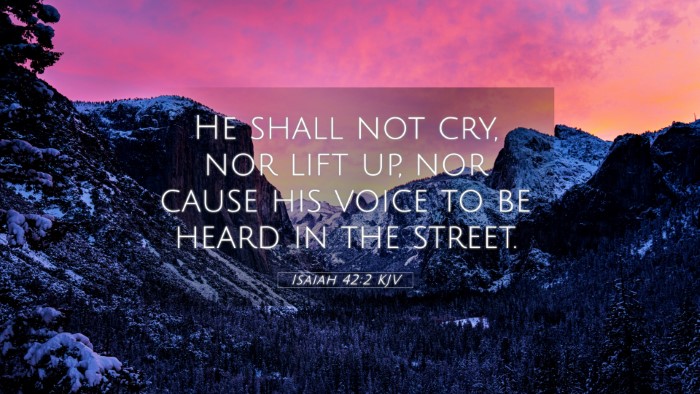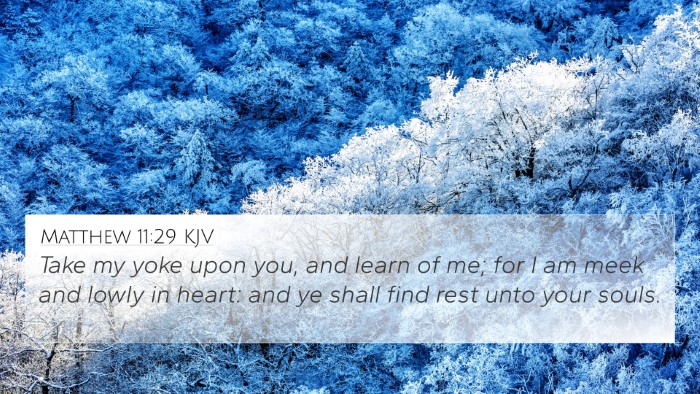Understanding Isaiah 42:2
Isaiah 42:2 states: "He will not cry out, nor raise His voice, Nor cause His voice to be heard in the street." This verse is significant in understanding the character and mission of the Messiah as prophesied in the Old Testament.
Meaning and Interpretation
This verse provides insight into the nature of the servant of the Lord, foreshadowing Jesus Christ. The emphasis on silence and restraint depicts the profound humility with which the Messiah will carry out His ministry. The absence of boisterous proclamation implies a purposeful and gentle approach to His mission.
Key Insights from Commentaries
- Matthew Henry: Henry emphasizes that the servant's quietness represents His meekness and the unpretentious manner of His ministry, in stark contrast to the expectations of a kingly figure. He points out that true influence stems from integrity and righteousness rather than loudness or force.
- Albert Barnes: Barnes highlights the importance of the servant's demeanor as a means of attraction to the weary and oppressed. The silent strength signifies a gentle Spirit at work, inviting those in need to come and receive comfort, displaying the fulfillment of the prophecy of the Messiah.
- Adam Clarke: Clarke speaks to the idea that the servant's yet-to-be-revealed triumph will come not from human means or violence but from the quiet degeneracy of the world and the response of the people to His loving manner of engagement.
Cross-References for Isaiah 42:2
This verse connects with various other scriptures that echo similar themes of humility, gentleness, and the nature of the Messiah. Here are some notable cross-references:
- Matthew 12:19 - This New Testament verse directly quotes Isaiah 42:2, affirming Jesus' gentle approach.
- Philippians 2:7-8 - Here, Paul illustrates Jesus' humility as He takes the form of a servant, echoing Isaiah's prophecy.
- Zechariah 9:9 - This verse describes a humble king arriving on a donkey, highlighting the meekness associated with the Messiah.
- 2 Corinthians 10:1 - Paul appeals to the humility of Christ, reinforcing the theme of gentle leadership.
- 1 Peter 2:23 - Peter reflects on Jesus’ response to mistreatment, portraying His silence and composure.
- John 1:29 - In declaring Jesus as the Lamb of God, the passage emphasizes His sacrificial role without ostentation.
- Isaiah 53:7 - This verse details the suffering servant's silence before His accusers, connecting closely to the message of Isaiah 42.
- Matthew 5:5 - Blessed are the meek, aligning with the character of the Messiah described in Isaiah.
- Lamentations 3:28-29 - Reflects on silence as a posture of waiting on the Lord, resonating with Isaiah's tone.
- Luke 4:18-19 - Jesus reading from Isaiah in the synagogue ties His mission to the prophecy, showcasing His purpose as the gentle healer.
Thematic Connections
Isaiah 42:2 invites exploration into the broader themes of humility and gentle leadership. These qualities are not only upheld through the life and ministry of Jesus but are also echoed throughout the teachings of the New Testament, inviting believers to model these traits.
Developing Cross-Referencing Skills
The ability to link scriptures such as Isaiah 42:2 to other passages is essential for depth in Bible study. Tools like a Bible concordance or a cross-reference Bible study guide can greatly assist in this pursuit. Learning methods for effective cross-referencing enhances understanding of biblical themes and encourages comprehensive Bible study.
@ How to Use Bible Cross-References
To effectively utilize Bible cross-references, consider:
- Identifying Themes: Observe common themes between verses to create connections.
- Comparative Analysis: Analyze the context of each verse to draw deeper insights.
- Inter-Biblical Dialogue: Engage in the conversation between texts, particularly between the Old and New Testaments.
- Study Tools: Use available resources that focus on comprehensive cross-referencing.
Conclusion
The understanding of Isaiah 42:2 provides rich insights into the nature of Christ and His mission, illustrating a leadership style characterized by humility and gentleness. By exploring related scriptures, one can appreciate the cohesive narrative woven throughout the Bible, facilitating deeper comprehension of these pivotal themes.








